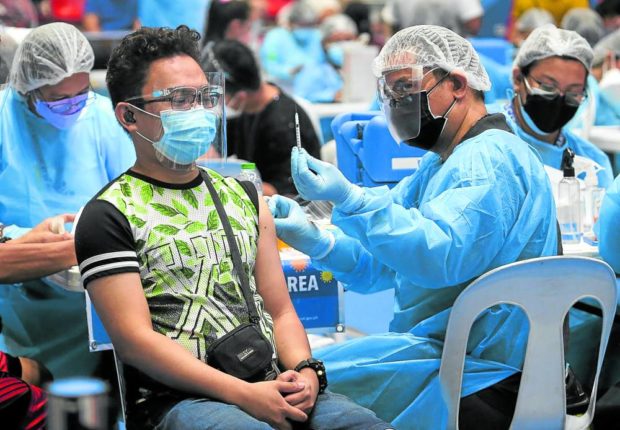MedIcal, nursing students may now volunteer for national jab drive

INTERNSHIP Postgraduate or undergraduate interns, clinical clerks and fourth year medicine and nursing students have been cleared to serve as screeners, vaccinators and vaccination monitors as part of their internship. —LYN RILLON
MANILA, Philippines — Medical and nursing students are now eligible to take part in the government’s vaccination drive under a joint memorandum signed by the Commission on Higher Education (CHEd) and the Department of Health (DOH).
Postgraduate or undergraduate interns, clinical clerks and fourth year medicine and nursing students who will be supervised by licensed physicians and nurses can volunteer as health screeners, vaccinators and pre/post vaccination monitors, CHEd said on Saturday.
The national government is ramping up the vaccination rollout as more COVID-19 vaccines arrive.
“As we increase the number of vaccination sites and increase daily targets, these additional vaccinators and support staff are critical to achieve herd immunity in the next two months,” CHEd Chair Prospero de Vera III said.
Among those institutions covered by Joint Memorandum Circular No. 2021-003 are public universities and colleges and higher education institutions (HEIs) with nursing and/or medical schools.
Article continues after this advertisementVoluntary
The local governments and local vaccination operations centers are required to set the number of personnel for their vaccination workforce.
Article continues after this advertisement“The participation of postgraduate or undergraduate interns, clinical clerks and fourth year nursing students in the National COVID-19 Vaccine Deployment and Vaccination Program as part of the vaccination workforce shall be voluntary in nature,” the document read.
Their volunteer work and hours rendered for service will be credited to their internship. The vaccination team’s head will also provide certification.
Cops, soldiers, too
Since October, the commission has been pushing for school-based vaccination in private and public HEIs.
The agency will submit to the DOH its data on the number of participating HEIs and hospitals as well as the volunteers due to be deployed.
CHEd is set to orient its regional offices as well as the universities and colleges on the circular.
The regional offices will coordinate with the HEIs on the inventory of student-volunteer vaccinators and partner with the DOH and local governments on their assignments in the different vaccination sites.
All uniformed services will also be tapped for the vaccination drive, according to Interior Secretary Eduardo Año.
“Every city, municipality, province [is] already coordinating with the uniformed services,” he told radio station dzBB on Sunday. “We will be maximizing the Philippine National Police and the Armed Forces of the Philippines so we have enough manpower to implement the health protocols.”
Meanwhile, a party list lawmaker on Sunday criticized the government for delays in the procurement of syringes.
“Deploying COVID[-19] vaccines to the [local governments] without the proper syringes and supplies is like sending the police their supplies of bullets but without the matching guns,” BHW Rep. Angelica Natasha Co said in a statement.
1,926 new cases
Newly detected COVID-19 cases remained below the 2,000 mark on Sunday’s case bulletin, although the death toll rose by more than 300, going into the second week after most pandemic restrictions have been lifted.
The DOH reported 1,926 new infections, bringing total cases to 2,816,980 since the pandemic began in March last year.
The latest bulletin had 309 deaths, including 216 which were previously tagged as recoveries. This pushed the country‘s COVID-19 death toll to 45,581.
The department said 3,140 more people have recovered, bringing the total number of survivors to 2,743,297.
There were 28,102 active cases, the lowest since Feb. 21, of which 62.3 percent were mild, 5.8 percent were asymptomatic, 16.9 percent were moderate, 10.5 percent were severe and 4.5 percent were critical.
Out of 40,996 tested last Saturday, 3.9 percent or 1,599 were found positive of the coronavirus.
Of the hospital beds in use nationwide, 34 percent of beds in the intensive care unit, 29 percent of isolation beds and 22 percent of ward beds are currently utilized, together with 21 percent of ventilators.